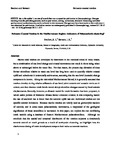Holocene coastal notches in the Mediterranean region: Indicators of palaeoseismic clustering?
| dc.contributor.author | Boulton, SJ | |
| dc.contributor.author | Stewart, IS | |
| dc.date.accessioned | 2016-03-30T11:05:38Z | |
| dc.date.available | 2016-03-30T11:05:38Z | |
| dc.date.issued | 2015-05-15 | |
| dc.identifier.issn | 0169-555X | |
| dc.identifier.issn | 1872-695X | |
| dc.identifier.uri | http://hdl.handle.net/10026.1/4441 | |
| dc.description.abstract |
Marine tidal notches are developed by bioerosion in the intertidal zones of rocky coasts, but a combination of sea-level change and crustal movements can result in them being raised above or submerged below the water line. For that reason, the present-day elevation of these former shorelines relative to the mean sea level has long been used to quantify relative coastal uplift and subsidence in tectonically active areas, assuming that the sea-level (eustatic) change component is known. Along the microtidal Mediterranean littoral, it is generally assumed that notches develop during relative stillstands of sea level, when tectonic and eustatic trends are in unison, and that discrete notch levels record abrupt shoreline changes caused by local seismic displacements. Recently, however, a climatic model for notch formation has been proposed, in which stable periods of Holocene climate favour enhanced erosion; in this competing model, the rate of sea-level rise is lower than the tectonic uplift rate and individual notches are not specific seismic indicators. Because marine notches are widely used as geomorphic markers of tectonic, and in some cases palaeoseismic, movements, a reappraisal of the geological significance of these strandlines is warranted. In this paper, we explore the two conflicting notch models using a database of Eastern Mediterranean palaeoshorelines. Although we conclude that the spatial and temporal distribution of the notches supports a dominantly tectonic control on notch genesis as a result of earthquake clustering, we highlight how the diachronous timing of notch development tempers their value as tectonic markers. | |
| dc.format.extent | 29-37 | |
| dc.language | en | |
| dc.language.iso | en | |
| dc.publisher | Elsevier BV | |
| dc.subject | Bioerosion | |
| dc.subject | Marine notch | |
| dc.subject | Neotectonics | |
| dc.subject | Mediterranean paleoseismology | |
| dc.subject | Climate | |
| dc.title | Holocene coastal notches in the Mediterranean region: Indicators of palaeoseismic clustering? | |
| dc.type | journal-article | |
| dc.type | Article | |
| plymouth.author-url | https://www.webofscience.com/api/gateway?GWVersion=2&SrcApp=PARTNER_APP&SrcAuth=LinksAMR&KeyUT=WOS:000355025800003&DestLinkType=FullRecord&DestApp=ALL_WOS&UsrCustomerID=11bb513d99f797142bcfeffcc58ea008 | |
| plymouth.volume | 237 | |
| plymouth.publication-status | Accepted | |
| plymouth.journal | Geomorphology | |
| dc.identifier.doi | 10.1016/j.geomorph.2013.11.012 | |
| plymouth.organisational-group | /Plymouth | |
| plymouth.organisational-group | /Plymouth/Faculty of Science and Engineering | |
| plymouth.organisational-group | /Plymouth/Faculty of Science and Engineering/School of Geography, Earth and Environmental Sciences | |
| plymouth.organisational-group | /Plymouth/REF 2021 Researchers by UoA | |
| plymouth.organisational-group | /Plymouth/REF 2021 Researchers by UoA/UoA07 Earth Systems and Environmental Sciences | |
| plymouth.organisational-group | /Plymouth/Research Groups | |
| plymouth.organisational-group | /Plymouth/Research Groups/Marine Institute | |
| plymouth.organisational-group | /Plymouth/Users by role | |
| plymouth.organisational-group | /Plymouth/Users by role/Academics | |
| plymouth.organisational-group | /Plymouth/Users by role/Researchers in ResearchFish submission | |
| dcterms.dateAccepted | 2013-11-26 | |
| dc.rights.embargodate | 2016-05-15 | |
| dc.identifier.eissn | 1872-695X | |
| dc.rights.embargoperiod | 12 months | |
| rioxxterms.versionofrecord | 10.1016/j.geomorph.2013.11.012 | |
| rioxxterms.licenseref.uri | http://www.rioxx.net/licenses/under-embargo-all-rights-reserved | |
| rioxxterms.licenseref.startdate | 2015-05-15 | |
| rioxxterms.type | Journal Article/Review |


